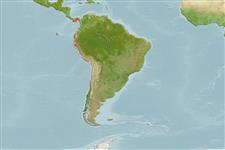>
Eupercaria/misc (Various families in series Eupercaria) >
Sciaenidae (Drums or croakers)
Etymology: Paralonchurus: Greek, para = the side of + Greek, logchos = lance + Greek, oura = tail (Ref. 45335).
More on author: Steindachner.
Environment: milieu / climate zone / depth range / distribution range
Écologie
marin démersal; profondeur 10 - ? m. Tropical; 9°N - 20°S, 82°W - 70°W (Ref. 112843)
Eastern Pacific: Panama to northern Chile.
Length at first maturity / Taille / Poids / Âge
Maturity: Lm ?, range 24 - ? cm
Max length : 51.0 cm TL mâle / non sexé; (Ref. 55763); common length : 30.0 cm TL mâle / non sexé; (Ref. 55763)
Description synthétique
Clés d'identification | Morphologie | Morphométrie
Body elongate, moderately compressed, with an arched dorsal profile; snout prominent; mouth small and inferior; lower jaw enclosed by upper; chin with 5 pores and 12 to 15 pairs of small barbels; edge of preopercle smooth; lower branch of first gill arch with 10 to 14 gill rakers; body uniformly dark and silvery; flanks with 7 or 8 indistinct bars; fins dark (Ref. 55763).
Found along sandy coasts and in bays (Ref. 9118). Feeds mainly on worms and other benthic invertebrates (Ref. 9118). Common in local markets (Ref. 9118).
Life cycle and mating behavior
Maturities | Reproduction | Spawnings | Egg(s) | Fecundities | Larves
Chao, L.N., 1995. Sciaenidae. Corvinas, barbiches, bombaches, corvinatas, corvinetas, corvinillas, lambes, pescadillas, roncachos, verrugatos. p. 1427-1518. In W. Fischer, F. Krupp, W. Schneider, C. Sommer, K.E. Carpenter and V. Niem (eds.) Guia FAO para identificacion de especies para los fines de la pesca. Pacifico Centro-oriental. 3 volumes. 1813 p. (Ref. 9118)
Statut dans la liste rouge de l'IUCN (Ref. 130435)
Menace pour l'homme
Harmless
Utilisations par l'homme
Pêcheries: commercial; Aquarium: Commercial
Outils
Articles particuliers
Télécharger en XML
Sources Internet
Estimates based on models
Preferred temperature (Ref.
123201): 17 - 22.8, mean 20.4 °C (based on 14 cells).
Phylogenetic diversity index (Ref.
82804): PD
50 = 0.5156 [Uniqueness, from 0.5 = low to 2.0 = high].
Bayesian length-weight: a=0.00759 (0.00472 - 0.01218), b=3.11 (2.98 - 3.24), in cm total length, based on LWR estimates for this species & (Sub)family-body (Ref.
93245).
Niveau trophique (Ref.
69278): 2.2 ±0.1 se; based on diet studies.
Résilience (Ref.
120179): Milieu, temps minimum de doublement de population : 1,4 à 4,4 années (Assuming tm=2).
Fishing Vulnerability (Ref.
59153): Moderate vulnerability (40 of 100).
Climate Vulnerability (Ref.
125649): Very high vulnerability (80 of 100).
Nutrients (Ref.
124155): Calcium = 134 [77, 299] mg/100g; Iron = 1.13 [0.57, 2.08] mg/100g; Protein = 18.4 [17.1, 19.6] %; Omega3 = 0.175 [0.089, 0.309] g/100g; Selenium = 60 [31, 128] μg/100g; VitaminA = 14 [4, 47] μg/100g; Zinc = 1.42 [0.99, 2.12] mg/100g (wet weight);
